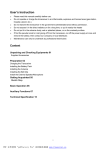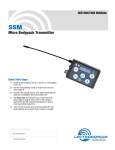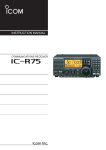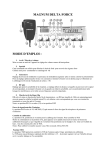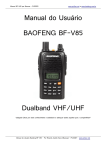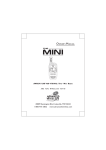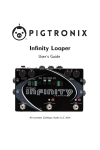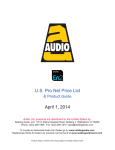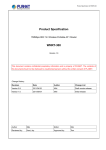Download THANK YOU! We are grateful for your purchase of Advanced
Transcript
THANK YOU! We are grateful for your purchase of Advanced Wireless Communications product. We believe this easy-to-use radio will provide you with dependable and reliable communications. This Advanced Wireless Communications portable two-way radio is a precision device. Treat it with care, and you will enjoy years of reliable operation. MODELS COVERED IN THIS MANUAL I-Rad: UHF 450-470 MHz Model Number: 420855102108 I Product Safety and RF Exposure for Portable Two-Way Radios Compliance with RF Energy Exposure Standards NOTICE: This radio is intended for use in occupational/controlled applications where users have been made aware of the potential for exposure and can exercise control over their exposure. This radio device is NOT authorized for general population, consumer or similar use. BEFORE USING THIS RADIO, READ THE TRAINING MATERIAL BELOW WHICH CONTAINS IMPORTANT OPERATING INSTRUCTIONS FOR SAFE USAGE AND RF ENERGY AWARENESS AND CONTROL INFORMATION FOR COMPLIANCE WITH RF ENERGY EXPOSURE LIMITS IN APPLICABLE NATIONAL AND INTERNATIONAL STANDARDS. Federal Communication Commission (FCC) Regulations The FCC has established limits for safe exposure to radio frequency (RF) emissions from portable two-way radios. The FCC requires manufacturers to demonstrate compliance with RF exposure limits before portable two-way radios can be marketed in the U.S. When two-way radios are approved for occupational/controlled environment exposure limits, the FCC requires users to be fully aware of, and exercise control over, their exposure. Awareness and control of RF exposure can be accomplished by the use of labels, or by education and training through appropriate means, such as information and instructions in user manuals or safety booklets. Your Advanced Wireless two-way radio has an RF exposure information label in the battery compartment. The training material below includes useful information about RF exposure and helpful instructions on how to control your RF exposure. Your Advanced Wireless two-way radio is designed and tested to comply with a number of national and international standards and guidelines (listed below) regarding human exposure to RF electromagnetic energy. In terms of measuring RF energy for compliance with FCC exposure guidelines, your radio radiates measurable RF energy only while it is transmitting (during talking), not when it is receiving (listening) or in standby mode. Compliance and Control Guidelines and Operating Instructions for Portable Two-Way Radios To control your exposure and ensure compliance with the occupational/controlled environment exposure limits, always adhere to the following procedures: * Transmit no more than 50% of the time. To transmit (talk), push the Push-To-Talk (PTT) button. To receive calls, release the PTT button. Transmitting 50% of the time or less is important since the radio generates measurable RF energy exposure only when transmitting (in terms of measuring standards compliance). * For body-worn operation, always place the radio in an AWC approved belt-clip or similar accessory that contains no metallic components and provides a minimum separation distance of 1.3 cm between the back of the radio and the user’s body. AWC-approved accessories, antennas, and device combinations comply with the occupational/controlled environment RF exposure limits. Using non–AWC approved accessories may result in exposure levels which exceed the FCC’s occupational/controlled environment RF exposure limits. AWC-approved accessories have been tested and comply with FCC RF exposure requirements. * If you are not using a body-worn accessory and are not using the radio held in front of the face, ensure the radio is kept a minimum of 1.3 cm from the body when transmitting. Keeping the radio at a proper distance is important since RF exposure decreases with increasing distance from the antenna. *Use only FCC-approved supplied or replacement headsets, batteries, and accessories intended for use with this radio. Use of non–FCC approved headsets, batteries and accessories may exceed FCC RF exposure guidelines. II FCC license Information Your Advanced Wireless Communications radio operates on communications frequencies which are subject to FCC (Federal Communications Commission) Rules & Regulations. FCC Rules require that all operators using Private Land Mobile radio frequencies obtain a radio license before operating their equipment. Application for license must be made on FCC form 601, and schedules D, E, and G. FAX: Forms can be obtained by fax from the FCC Fax-On-Demand system. Call 1-202-418-0177 from your fax machine and request document number 000600 for the form, schedules, and instructions. MAIL: Forms can be ordered by telephone, and will be sent to you by first class mail. Call the FCC Forms Hotline at 1-800-418-FORM (1-800-418-3676). INTERNET: Form 601 and instructions can be downloaded from the FCC Forms website at: http://www.fcc.gov/Forms/Form601/601.html Before filling out your Form 601 application Technical Data section, you must decide which frequency (or frequencies) you will operate on. Refer to the frequency chart on page 26. Questions? Call the FCC for license application questions at 1-888-CALL-FCC (1-888-225-5322). If you have any questions, call Advanced Wireless Communications: 1-800-475-5852 Notices to The User This device complies with Part 15 of the FCC Rules. Operation is subject to the following two conditions: (1) this device may not cause harmful interference, and (2) this device must accept any interference received, including interference that may cause undesired operation. One or more of the following statements may be applicable: FCC WARNING This equipment generates or uses radio frequency energy. Changes or modifications to this equipment may cause harmful interference unless the modifications are expressly approved in the instruction manual. The user could lose the authority to operate this equipment if an unauthorized change or modification is made. INFORMATION TO THE DIGITAL DEVICE USER REQUIRED BY THE FCC This equipment has been tested and found to comply with the limits for a Class B digital device, pursuant to Part 15 of the FCC Rules. These limits are designed to provide reasonable protection against harmful interference in a residential installation. This equipment generates, uses and can generate radio frequency energy and, if not installed and used in accordance with the instructions, may cause harmful interference to radio communications. However, there is no guarantee that the interference will not occur in a particular installation. If this equipment does cause harmful interference to radio or television reception, which can be determined by turning the equipment off and on, the user is encouraged to try to correct the interference by one or more of the following measures: • Increase the separation between the equipment and receiver. • Connect the equipment to an outlet on a circuit different from that to which the receiver is connected. • Consult the dealer for technical assistance. III SAFETY INFORMATION: Your wireless portable two-way radio has been designed using a low power transmitter. When the PTT switch is pressed, the radio generates radio frequency (RF) electromagnetic energy (EME). This radio is designed to comply with the FCC Report and Order FCC 96-326 (August, 1996). User Safety Information PLEASE READ THIS IMPORTANT INFORMATION BEFORE USING YOUR Advanced Wireless Communications PORTABLE TWO-WAY RADIO. ◇ Only qualified technicians are allowed to maintain this product. ◇ To avoid electromagnetic interference, turn off your radio in places where posted notices instruct you to do so. Hospitals or health care facilities may be using equipment that is sensitive to external RF energy. When traveling on aircraft, turn off your radio when the airline crew instructs you to do so. ◇ When in vehicles equipped with an air bag, do not place a portable radio in the airbag deployment area. ◇ Turn off your radio prior to entering any area with a potentially explosive atmosphere. Do not remove, install, or charge batteries in such areas. ◇ To avoid possible interference with blasting operations, turn off your radio when you are near electrical blasting caps. ◇ Do not expose the radio to direct sunlight for long periods of time. Do not place the radio in direct contact with any heating source. IV CONTENTS Thank You ...................................................................................................................... I FCC Declaration ............................................................................................................. II – IV Contents ......................................................................................................................... V Introduction ................................................................................................................... Getting Acquainted ................................................................................….................... Product Inspection …............................................................................................... Transceiver Radio View ........................................................................................... Cradle Charger View .........................................................................................…... Safety and Care Instructions ........................................................................................ Safety Precautions ................................................................................................... Caring for this Product ............................................................................................. Caution ..................................................................................................................... Getting Started ............................................…............................................................... Installing / Removing the Battery .....................................................................….… Installing the Headset .............................................................................................. Features and Operation ..........................................................................................…... Turn the unit ON/OFF ...........................................................................……………. Volume Adjustment .................................................................................................. Keypad Lock .......……………................................................................................... Talk to another Transceiver …......................................................................................... Select a Channel ............…..…..….............….................................................................. Auxiliary Functions ............…................................................................…… Time-Out Timer (TOT) ............….............................................................................. Low Battery Warning ............…................................................................ Monitor ............….................................................................................. Troubleshooting ..................................................................................………………….. Optional Accessories ..................................................................................................... Specifications ................................................................................................................. Appendix V 1 1 1 2 3 4 4 4 4 4 4 5 6 6 6 6 7 7 8 8 8 8 8 8 9 INTRODUCTION Advanced Wireless Communications is a leader in the design and integration of wireless communications solutions. Since 1992, we’ve been creating on site wireless systems that help businesses communicate effectively. Whether it’s a national chain of retail stores, a 50-story office tower, construction site, a large distribution center, a college campus or a retirement home, Advanced Wireless has the expertise and experience to create the best solution possible... We’re ready to partner with you to make your communications more effective and efficient. Ken & Ben Coons Founders of Advanced Wireless Communications GETTING ACQUAINTED PRODUCT INSPECTION Thank you for your purchase of Advanced Wireless Communications portable two-way radio model: I-Rad 420855102108. Before use, please inspect the product as follows. First check the shipping carton for any signs of damage if any damage has occurred, please contact your dealer immediately. Confirm the supplied product against the packing slip to assure accuracy. PACKAGING CONTENTS: 1. 2. 3. 4. 5. Part number 420855102108 420855207490 420855207469 420855207452 420855207476 Item I-RAD Transceiver Flexible earloop Charger, single drop in for I-RAD Li-on Battery pack for I-RAD Wall transformer for I-RAD (1) (3) Oty. 1 pc 1 pc 1 pc 1 pc 1 pc (2) (4) 1 (5) TRANSCEIVER RADIO VIEW 4 5 6 1 2 7 8 3 Front View: 1. 2. 3. 4. Headset Connector Connect headset for hands-free communication 2.5mm Jack PTT (Push to talk) Button Press and hold PTT, Transmit mode enabled. Release PTT, Receive mode enabled. LED indicator LED indication and corresponding radio status as follows: Radio status Transmitting Receiving busy Receiving standby 5. 6. 7. 8. LED indication (normal voltage) Red LED Green LED Green LED slowly flashes (5s:0.1s) VOL + / Power Button Press and hold more than 3 seconds to turn the unit On /Off. button to increase volume CH + Button Press to increase channel no. VOL – Button Press to decrease volume CH – Button Press to decrease channel no. 2 LED indication (Low voltage) Red LED flash (1s:0.1s) While radio is on, press 1 2 3 4 Back View: 1. Belt Clip Used to clip the radio on your belt. Battery door Remove to access battery compartment. Battery pack Lithium 4.2V /1050mAH rechargeable battery pack. Charging Battery Contact Charging Battery 2. 3. 4. CRADLE CHARGER VIEW 1 3 2 1. 2. 3. 4. 5. 4 Battery Slot Charges Battery Charging Indicator Radio Charging Indicator Radio Slot Charges Radio Unit Charging Indicator Battery Charging Indicator Power Input Jack Power input 3 5 SAFETY AND CARE INSTRUCTIONS SAFETY PRECAUTIONS Please observe the following safety precautions when setting up and using this product. • Heat sources – Keep the product away from heat sources such as radiators, stoves, heaters, and other heat-generating products. • Water and moisture – Do not use the product in or near water or in high moisture areas such as a bathroom. Indoor use only. CARING FOR THIS PRODUCT To ensure you receive the maximum benefit from using this product, please observe the following guidelines. • Cleaning – Use a damp cloth. Do not use liquid cleaning agents, benzene, thinner, or aerosols. • Repair – Do not attempt to repair the product or modify the circuitry by yourself. Only replacement parts that are recommended by Advanced Wireless Communications at 1-800-475-5852 are to be used. CAUTION • • • • • • • To avoid risk of fire or injury, do not attempt to charge non-rechargeable batteries. Please turn off the unit while charging. Replace only batteries with the same or equivalent type recommended by the manufacturer. Please dispose of old, defective batteries in an environmentally friendly manner in accordance with the relevant legislation. See additional battery warnings in the“WARNING"section of the user manual. Do not dispose this product as unsorted municipal waste. Collection of such waste separately for special treatment is necessary. No naked flames, such as lighted candles, should be placed near the apparatus. To reduce the risk of electric shock, do not expose this application to rain or moisture. GETTING STARTED INSTALLING / REMOVING THE BATTERY To insert the battery: 1. Slide open battery door. 2. Insert the lithium battery into the battery compartment, making sure the polarities (+ and –) match. 3. Replace the back cover. WARNING Always make sure the radio is switched off before installing or changing the battery. Replace only with the same or equipment type. Use ONLY with lithium 4.2V 1050mAH rechargeable battery. Contact Advanced Wireless Communications at 1-800-475-5852 for 4 more information. When the battery power is low, Red LED will flash, please charge it or replace it with a new one. To charge the battery: TIP Charge the battery for 12 hours on the first charge. After that, it should take 4 hours or less to charge. 1. Plug the adaptor output into the socket on the rear side of charger. 2. The Desktop charger can charge both the radio and a separate battery. 3. The LED indicates the charging condition: one for radio unit, and another for separate battery. LED Green MEANING No battery in the cradle Unit / battery has been fully charged Unit / battery placed in cradle Red NOTE 1. To maintain the battery life of your radio it is recommended that you only charge the battery when needed. Overcharging the battery will reduce performance. 2. Ensure that the unit is turned off before charging. 3. Remove batteries before storing your radio for extended periods. Batteries corrode over time and may cause permanent damage to your radio. 4. Please use the specified power adaptor within the same rating. INSTALLING THE HEADSET Insert the headset into the connection at the top of the radio. Tighten the screw on the headset to secure it. There is generally a PTT button on the headset. 5 FEATURES AND OPERATION TURN THE UNIT ON / OFF NOTE Before using radio, confirm headset cable has been connected to the radio. To turn on Radio: Press and hold VOL+ “Power on” will sound and Green LED light will appear confirming your action. To turn off Radio: Press and hold VOL+ until you hear “Power off” VOLUME ADJUSTMENT To increase / decrease volume level: Press VOL+ or VOL–. Every time button is pressed, you will hear one “beep” sound. KEYPAD LOCK To lock / unlock the CH+, CH–, VOL+ & VOL– buttons: Press and hold VOL– until you hear “Lock” / “Unlock” respectively. 6 TALK TO ANOTHER TRANSCEIVER To Transmit (Make a call): Press and hold PTT button, Speak into the microphone using your normal speaking voice. TIP Activate MONITOR Function: To avoid interfering with other users, make sure the channel is idle before transmitting by pressing and holding the CH + button. This allows you to monitor other activities on your selected channel. To Receive (Finished speaking): Release the PTT button. Radio automatically switches to receive mode. Status of Radio is as follows: LED STATUS Red (constant) Transmitting Red (flashing) Battery voltage low (transmission stopped – refer to auxiliary function “Low Battery Warning” Green (constant) Receiving Green (flashing) Not transmitting / Receiving Green (flashing rapidly) Channel is busy however CTCSS / DCS code does not match radio set. NOTE You can only communicate with another transceiver that is on the same channel and using the same CTCSS/DCS code as your radio. NOTE For best transmission speak about 3-4 cm away from the microphone and after pressing PTT button, leave a short pause before speaking. SELECT A CHANNEL The transmitter and receiver must be on the same channel in order for you to communicate with another party. To select channels: Press CH+ or CH– to change channels. To check transmitter and receiver are using the same channel: Press PTT button. The other party should hear a distortion noise. NOTE By pressing once CH+ or CH–, a voice prompt will indicate which channel is currently being used / set; “one, two,…”. Press CH+ or CH– button again within a short time to increase / decrease the channel. New voice prompts will indicate the new channel setting. 7 AUXILIARY FUNCTIONS TIME-OUT TIMER (TOT) Time-out Timer prevents the prolonged use of the same channel and energy waste resulting from continued transmission. If the radio continuously transmits signals for a period over the preset limit (set by your dealer, max time is 5 minutes), the transceiver will stop transmitting and a beep will sound. To stop the tone, release the PTT button. Press the PTT button again to resume transmission. Battery Save This function minimizes the amount of power used when a signal is not being received and no operations are being performed (no buttons are being pressed). While the channel is not busy and no operation performed for 10 seconds, Battery Save turns ‘ON’. When a signal is received or an operation is performed, Battery Save turns ‘OFF’. LOW BATTERY WARNING Low Battery Warning alerts you when the battery needs to be recharged. While transmitting, if power of the battery goes below a pre-determined value, the red light will flash, a tone sound, and the radio will stop transmitting. Please replace or recharge the battery. MONITOR Pressing and holding CH + activates MONITOR Function. This function allows you to monitor other activities on your selected channel in receive mode. The squelch circuit on the radio automatically mutes the speaker when there are no signals, thereby eliminating background noise. Press and hold "CH +" to manually deactivate the squelch mechanism. This operation is especially useful for adjusting volume level or when receiving a weak signal. TROUBLESHOOTING See below for some common problems and their remedies. DO NOT attempt any repairs yourself. This will invalidate your warranty. PROBLEM Can’t turn the radio on Can’t communicate with other radios POSSIBLE CAUSES / REMEDIES ● Check the battery is correctly installed and has been fully charged ● For this and all other issues contact Advanced Wireless Communications at 1-800-475-5852 for more information. OPTIONAL ACCESSORIES Mini speaker mic (AWC P/N: 420855207483) Surveillance headset (AWC P/N: 420855207506) Earbud headset (AWC P/N: 420855207513) These products are available from: Advanced Wireless Communications at 1-800-475-5852 or www.advancedwireless.com 8 SPECIFICATIONS Operation frequency: Channels: CTCSS/DCS codes: Modulation: Sensitivity: Noise Squech: Audio output power: Audio distortion: Rx signal to noise ratio: Tx RF output power: Current drain while Receiving: Current drain while Transmitting: Current drain at Standby saving on/off: Charge current: Power supply: Low voltage indication: Dimensions (HxWxD): Weight (without batteries): 450-470 MHz 16 Max. (setting by PC programming) 38 CTCSS/ 83 DCS FM (Narrow/Wide deviation) -119 dBm ( -6 dBuV emf) Auto (setting by PC programming) > 50 mW <7% > 30 dB 1W (Hi) / 400mW (Low) < 150 mA < 1.2A (Hi) / 800 mA (Low) < 20/50 mA 450 mA 4.2V / 1050mAH Li-ion battery 2.8 ~ 3.2 V 115x53x29 mm (4.5x2.1x1.1 inch) 100 grams (2.5 oz) 9 Appendix Frequency Chart Model: Channel Serial Number: Transmit Frequency Transmit CTCSS/DCS Receive Frequency Receive CTCSS/DCS 1 2 3 4 5 6 7 8 9 10 11 12 13 14 15 16 Advanced Wireless Communications endeavor to achieve the accuracy and completeness of this manual, but cannot guarantee its accuracy at all times. All the above specifications and design are subject to change by Advanced Wireless Communications without notice. All the reproduction and translation of this manual without authorization of Advanced Wireless Communications is not allowed. 10

















